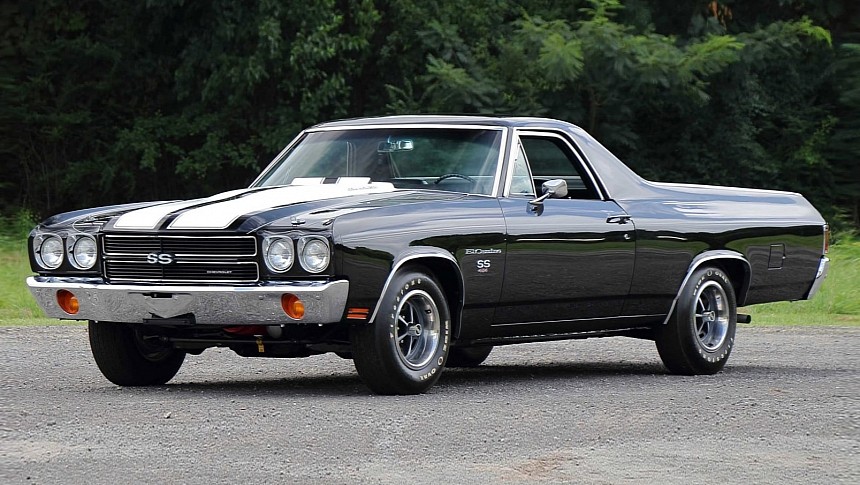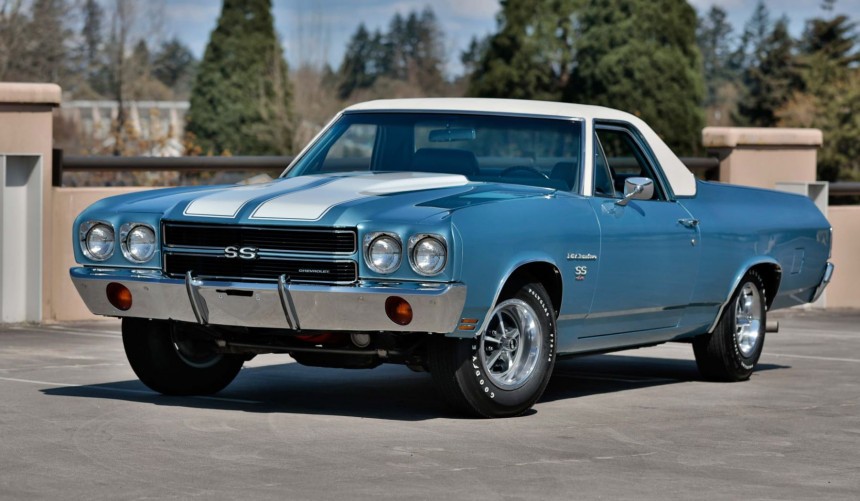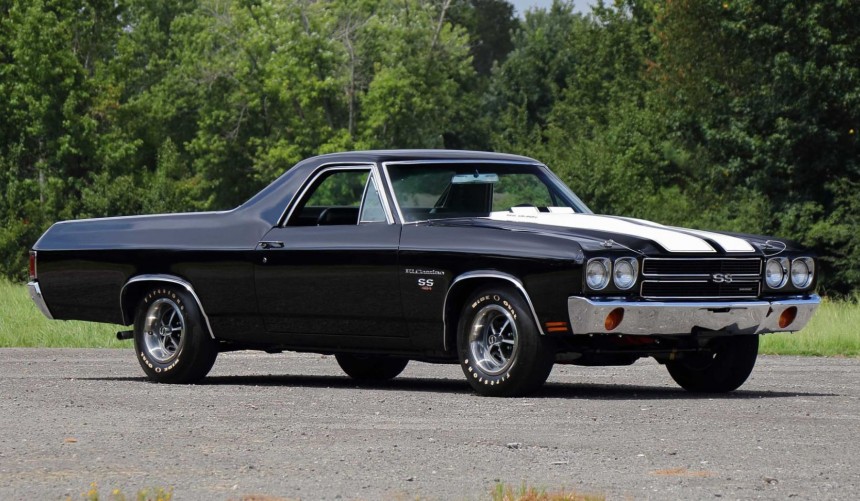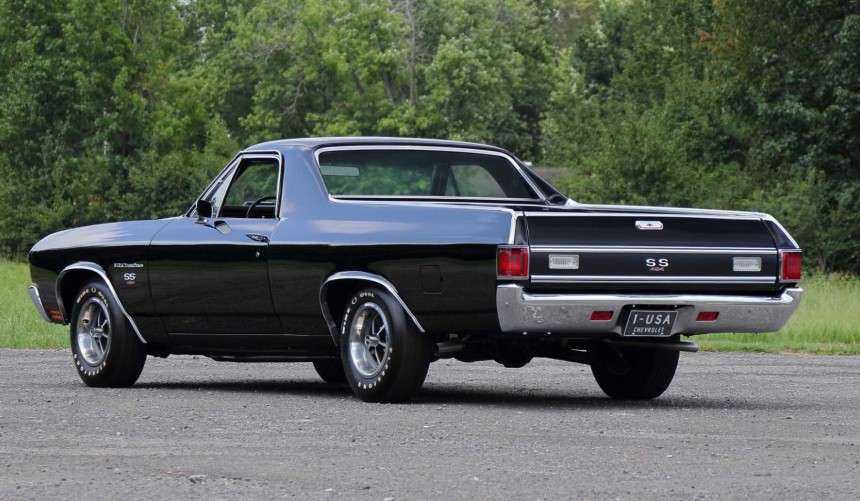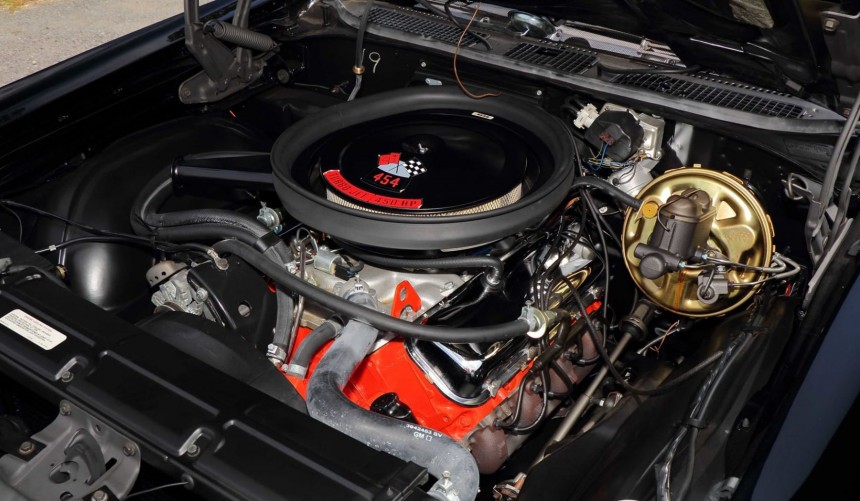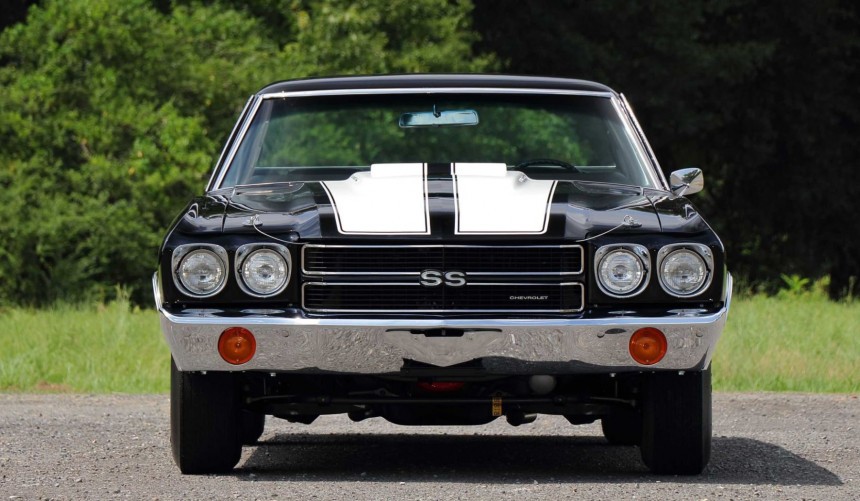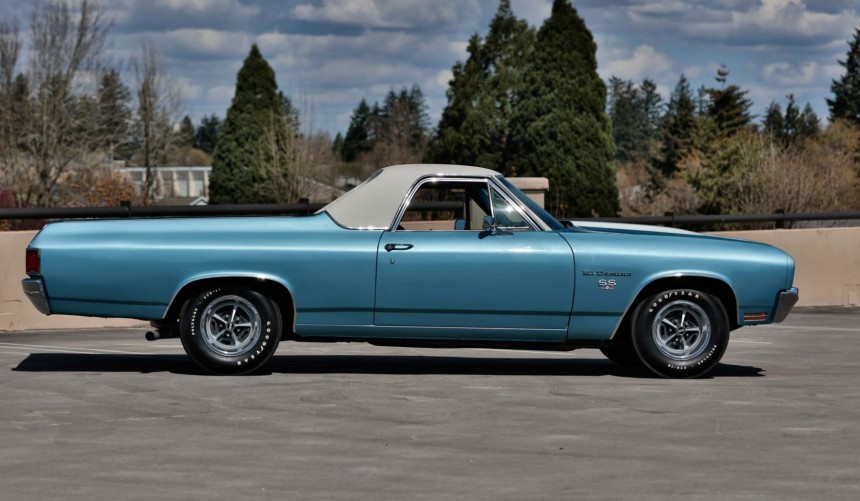A dependable workhorse from Monday to Friday and a Mopar assassin on Sunday, the El Camino SS 454 was a sport utility vehicle decades before the term was applied to vehicles that, in most cases, have nothing to do with sportiness.
The El Camino story started in 1959 when Chevy transformed the Brookwood two-door wagon into a competitor for the Australian ute-inspired Ford Ranchero launched in the US two years earlier.
However, unlike its Blue Oval rival, the first-generation El Camino wasn't particularly successful and only lasted on the market until the end of the 1960 model year.
Thankfully, the model made a comeback in 1964 as the pickup version of the intermediate Chevelle, and this time, sales were encouraging.
The second part of the 1960s was a period of gross excess across the American automotive industry.
Carmakers didn't settle for transplanting humongous V8s from full-size models into intermediates and started carrying them over to pony cars and even compacts.
Naturally, this trend tricked down to the Ranchero and El Camino pickups. While the Ford pickup received a 390-ci (6.4-liter) FE as its top option in 1967, Chevy added the Chevelle SS's base 396-ci (6.5-liter) big block to the El Camino's options list.
A year later, the Bowtie brigade decided to one-up its rival by adding the entire SS 396 package (not just the engine) to the El Camino lineup, giving birth to the first thoroughbred super car (as muscle cars were known back then) with a pickup bed.
Even in that era of excess, using the high-performance muscle car recipe on a utilitarian pickup was an idea that made absolutely no practical sense - apart from lower insurance rates in states where it was designated a pickup truck.
But Chevy did it anyway, much to the excitement of those who wanted to burn rubber at the strip on Sunday then use the same car to haul stuff on Monday.
Ford answered by adding the 428-ci (7.0-liter) Cobra Jet and Super Cobra Jet FEs to the Ranchero's options list mid-model year in 1968, but Chevy one-upped the Blue Oval again in 1970.
The 1970 model year was the pinnacle of muscle car madness across the American automotive industry.
With GM lifting its self-imposed ban on fitting engines larger than 400 ci (6.55 liters) on intermediate platforms, its divisions were suddenly free to go wild with their muscle car offerings.
Buick fitted its 455 (7.5-liter) in the GSX, Pontiac, and Olds introduced V8s with the same displacement in the GTO and 4-4-2, while Chevy bored out the 396 to 402-ci and made two new 454 versions available for the Chevelle and El Camino SS models.
Again, an SS 454 pickup made no practical sense, but that was an era when US carmakers built wild cars because they could, not because they should.
The famous phrase "business in the front, party in the back" was used to describe the mullet hairstyle, but in reverse, it fits the 1970 El Camino SS 454 like a glove.
With its SS-badged front grille, twin "Stereo" stripes, and standard domed (or optional cowl induction) hood, the pickup looked just like the flashy, freshly-restyled 1970 Chevelle SS from the front.
But, from the firewall to the tailgate, the SS pickup was nearly identical to the 1968-1969 El Camino (save from some trims), boasting an all-business 6.6-foot-long bed created on the heavy-duty backbone of the Chevelle four-door wagon.
Inside, the rabid pickup shared the dashboard, instrumentation, and standard bench seat with the Chevelle, but options like individual, power-adjustable "Strato-bucket seats" and a center console were optional.
While the standard SS396 was still available, albeit with the newly-bored-out 401, those who wanted even more power could opt for one of two 454 versions.
The first was the LS5 with five main bearings, hydraulic lifters, a Rochester four-barrel carb, and a 10.25:1 compression ratio that made 360 hp and 500 lb-ft (678 Nm) of tire shredding twist.
The second, more sought-after version was the LS6, which shared the same five main bearing block but added solid lifters, a hotter cam, larger valves, a higher compression ratio, and a more capable Holley carb.
With these upgrades, the LS6's torque rating was unchanged, but in terms of horsepower, the engine could spit out no less than 450 ponies.
With all that power, the LS6-equipped El Camino SS 454 became a HEMI-powered Mopar slayer that could run the quarter mile in the mid-13s at 108 mph (174 kph).
In both cases, the 455 came with a heavy-duty Muncie M22 four-speed mated to a 3.31:1 rear end as standard, but an M40 Turbo Hydra-Matic three-speed auto and a Positraction limited-slip diff were available as options.
While the El Camino SS 454 was just as fast and much more practical for hauling duties than its Chevelle SS sibling, it lacked one crucial upgrade.
To maintain its hauling capabilities, Chevrolet did not offer the F41 heavy-duty suspension for the SS-badged El Camino.
Even though it inherited the heavy-duty shocks and springs from the Chevelle wagon, the muscle pickup didn't receive the rear anti-roll bar included in the F41 option on the Chevelle SS coupe and convertible.
Without the anti-roll bar, an El Camino SS 454 with an empty bed was difficult to tame at high speeds, even when equipped with the Positraction diff.
On a rainy day, an inexperienced driver naive enough to floor it was guaranteed to see the rear bumper coming at him in the side mirror, which, at high speeds, was a deadly mistake.
Nevertheless, some enthusiasts ignored this potential danger and brought an El Camino SS 454 anyway.
The GM division didn't keep separate records of the El Camino SS sales, so we only know for sure that 8,773 Chevelles and El Caminos equipped with the 454 engines were sold during the 1970 model year. Out of those, it's estimated that around ten to twenty percent were pickups.
The SS 454 option returned in 1971 and 1972 but was only available in LS5-spec and had less power.
Today, the Chevelle SS 454 is one of the most sought-after muscle cars ever produced. Hence, a surviving example demands anywhere from $50,000 to over $100,000, depending on the engine option, mileage, and overall shape.
Despite being a lot rarer, surviving examples of the pickup version are usually around fifteen percent cheaper.
Part muscle car, part pickup truck, the 1970 El Camino SS 454 was one of the wildest models introduced during the golden age of muscle cars.
Combining a practical cargo bed with sporty looks and a high-performance powertrain, it was more adept at being called a sport utility vehicle than most of the tall hatchbacks and wagons that define the current SUV segment.
For a virtual tour of this magnificent ride, we recommend watching the YouTube video below by Patrick Glenn Nichols Musclecar Barn Finds.
However, unlike its Blue Oval rival, the first-generation El Camino wasn't particularly successful and only lasted on the market until the end of the 1960 model year.
Thankfully, the model made a comeback in 1964 as the pickup version of the intermediate Chevelle, and this time, sales were encouraging.
One-upping Ford with the Super Sport package
Carmakers didn't settle for transplanting humongous V8s from full-size models into intermediates and started carrying them over to pony cars and even compacts.
Naturally, this trend tricked down to the Ranchero and El Camino pickups. While the Ford pickup received a 390-ci (6.4-liter) FE as its top option in 1967, Chevy added the Chevelle SS's base 396-ci (6.5-liter) big block to the El Camino's options list.
A year later, the Bowtie brigade decided to one-up its rival by adding the entire SS 396 package (not just the engine) to the El Camino lineup, giving birth to the first thoroughbred super car (as muscle cars were known back then) with a pickup bed.
Even in that era of excess, using the high-performance muscle car recipe on a utilitarian pickup was an idea that made absolutely no practical sense - apart from lower insurance rates in states where it was designated a pickup truck.
But Chevy did it anyway, much to the excitement of those who wanted to burn rubber at the strip on Sunday then use the same car to haul stuff on Monday.
Taking it one step further
The 1970 model year was the pinnacle of muscle car madness across the American automotive industry.
With GM lifting its self-imposed ban on fitting engines larger than 400 ci (6.55 liters) on intermediate platforms, its divisions were suddenly free to go wild with their muscle car offerings.
Buick fitted its 455 (7.5-liter) in the GSX, Pontiac, and Olds introduced V8s with the same displacement in the GTO and 4-4-2, while Chevy bored out the 396 to 402-ci and made two new 454 versions available for the Chevelle and El Camino SS models.
Again, an SS 454 pickup made no practical sense, but that was an era when US carmakers built wild cars because they could, not because they should.
Party in the front, business in the back
With its SS-badged front grille, twin "Stereo" stripes, and standard domed (or optional cowl induction) hood, the pickup looked just like the flashy, freshly-restyled 1970 Chevelle SS from the front.
But, from the firewall to the tailgate, the SS pickup was nearly identical to the 1968-1969 El Camino (save from some trims), boasting an all-business 6.6-foot-long bed created on the heavy-duty backbone of the Chevelle four-door wagon.
Inside, the rabid pickup shared the dashboard, instrumentation, and standard bench seat with the Chevelle, but options like individual, power-adjustable "Strato-bucket seats" and a center console were optional.
A Big(er) Block under the hood
The first was the LS5 with five main bearings, hydraulic lifters, a Rochester four-barrel carb, and a 10.25:1 compression ratio that made 360 hp and 500 lb-ft (678 Nm) of tire shredding twist.
The second, more sought-after version was the LS6, which shared the same five main bearing block but added solid lifters, a hotter cam, larger valves, a higher compression ratio, and a more capable Holley carb.
With these upgrades, the LS6's torque rating was unchanged, but in terms of horsepower, the engine could spit out no less than 450 ponies.
With all that power, the LS6-equipped El Camino SS 454 became a HEMI-powered Mopar slayer that could run the quarter mile in the mid-13s at 108 mph (174 kph).
In both cases, the 455 came with a heavy-duty Muncie M22 four-speed mated to a 3.31:1 rear end as standard, but an M40 Turbo Hydra-Matic three-speed auto and a Positraction limited-slip diff were available as options.
Practical but deadly
To maintain its hauling capabilities, Chevrolet did not offer the F41 heavy-duty suspension for the SS-badged El Camino.
Even though it inherited the heavy-duty shocks and springs from the Chevelle wagon, the muscle pickup didn't receive the rear anti-roll bar included in the F41 option on the Chevelle SS coupe and convertible.
Without the anti-roll bar, an El Camino SS 454 with an empty bed was difficult to tame at high speeds, even when equipped with the Positraction diff.
On a rainy day, an inexperienced driver naive enough to floor it was guaranteed to see the rear bumper coming at him in the side mirror, which, at high speeds, was a deadly mistake.
Nevertheless, some enthusiasts ignored this potential danger and brought an El Camino SS 454 anyway.
The Chevrolet El Camino SS 454 today
The SS 454 option returned in 1971 and 1972 but was only available in LS5-spec and had less power.
Today, the Chevelle SS 454 is one of the most sought-after muscle cars ever produced. Hence, a surviving example demands anywhere from $50,000 to over $100,000, depending on the engine option, mileage, and overall shape.
Despite being a lot rarer, surviving examples of the pickup version are usually around fifteen percent cheaper.
Part muscle car, part pickup truck, the 1970 El Camino SS 454 was one of the wildest models introduced during the golden age of muscle cars.
Combining a practical cargo bed with sporty looks and a high-performance powertrain, it was more adept at being called a sport utility vehicle than most of the tall hatchbacks and wagons that define the current SUV segment.
For a virtual tour of this magnificent ride, we recommend watching the YouTube video below by Patrick Glenn Nichols Musclecar Barn Finds.
